I’d like to share with you this example of a seldom encountered Imperial Japanese Army, Meiji Era, enlisted full dress shako. From what I can gather this pattern dates from around 1886 and was worn in this configuration by line units, with the Imperial Guard wearing a similar shako but with a red body.
The difficult part of any discussion of this era’s uniforms and equipment by a non-Japanese speaker/reader is the lack of English language text available regarding the subject. There are a few collector’s books available dealing with this era, however most of those rely on drawings rather than photographs of actual artifacts, all with Japanese text.
Regardless, these artifacts do exist and deserve their place in the realm of militaria discussion and I hope the Pickelhaube Pals will be happy to read-on. Comments and additional information are most welcome.
During the reign of Emperor Meiji (1868-1912), Japan was in the midst of a major transition from a centuries old feudal society into the modern era, embracing much of the then, current Western technology during this transition.
In the military sphere, this transition occurred quite rapidly, the result of major influences by visiting European military missions. The French Army, then under the rule of Napoleon III, provided a great influence in uniforms and rank structure with this shako displaying that influence with a touch of German as well.
A basic description of the shako is as follows, lacquered leather body with a sewn visor with a bound edge, with the underside of the visor and sweatband in dark green Moroccan leather. There is a black painted, domed metal ventilator on each side of the body, a brass chinstrap boss below with a German style single brass chinstrap segment. The remainder of the original chinstrap would have been a simple leather strap with a steel or brass securing buckle. On the front of the shako is an elaborate brass starburst emblem, with a narrow, metal reinforced hole in the shako’s top for a feathered plume. The interior of the shako displays a wide 19th century style leather sweatband, with a white muslin lining with drawstring and a paper label glued into the top.
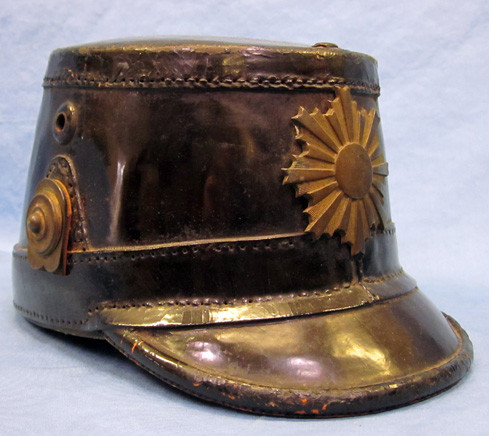
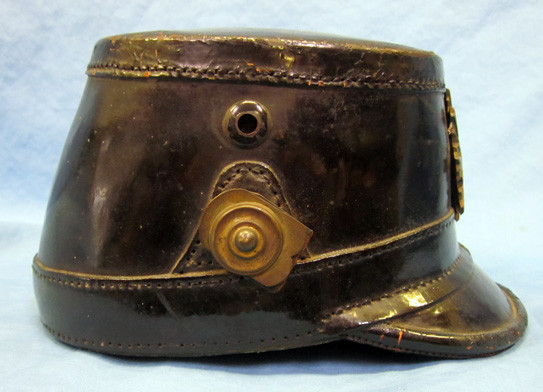
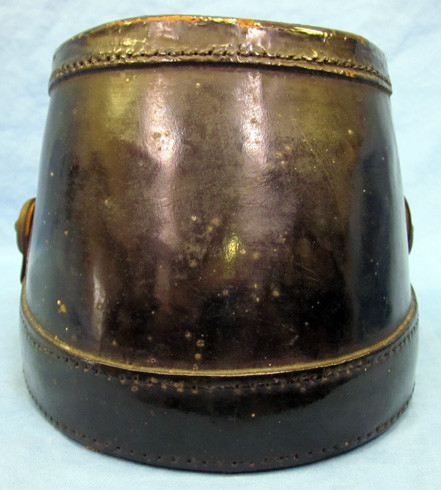
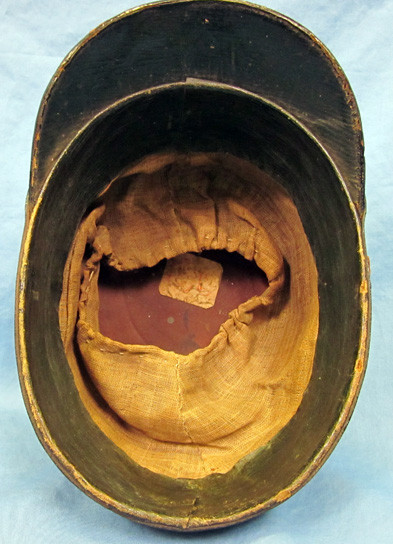
The other photographs are provided to act as a sort of filler with the color photograph illustrating another surviving example of the enlisted shako. That photograph and the image of the three enlisted men (with the soldier on the left wearing a similar pattern shako), are courtesy of the collection of Nakata-San, of Nakata-Shoten, Tokyo. They appear in his book, Imperial Japanese Army & Navy, Uniforms & Equipment, Vol. II.
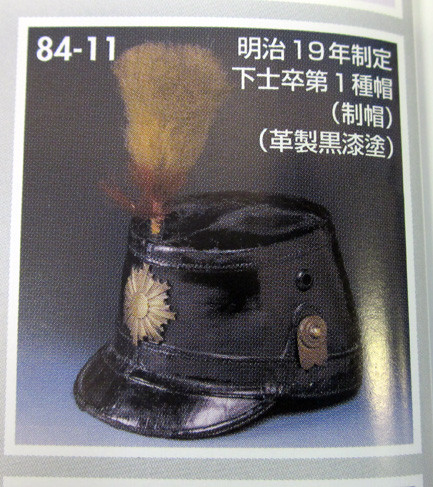
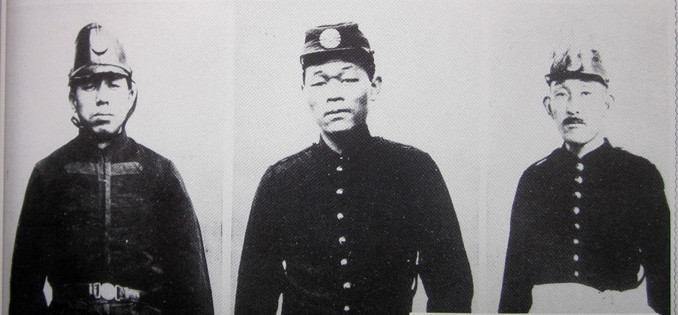
The visor hat is a Meiji Era Army Warrant Officer which rests on the scabbard of a similar era officers kyu-gunto service sword with a Russo-Japanese War Campaign Medal to the side. Of interest is that the blade of this sword dates between 1620-1640, nicely illustrating the honor-tradition of Japanese officers carrying centuries-old family swords into battle.
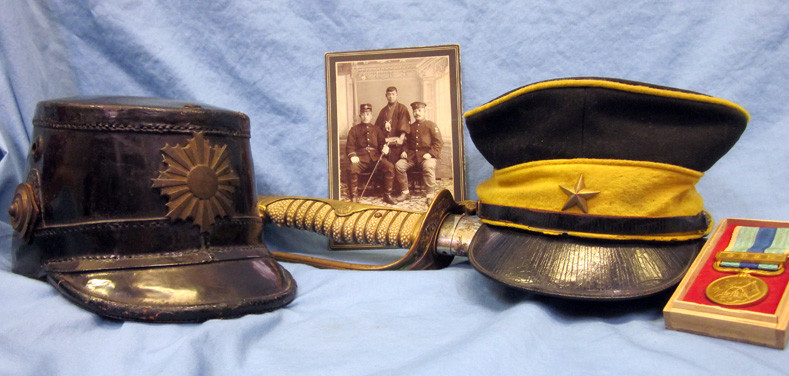
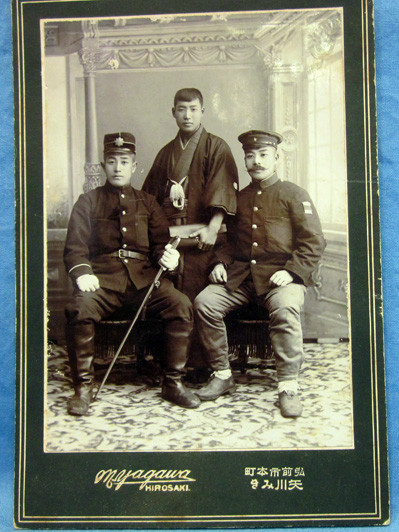
Cheers :thumb up:
The difficult part of any discussion of this era’s uniforms and equipment by a non-Japanese speaker/reader is the lack of English language text available regarding the subject. There are a few collector’s books available dealing with this era, however most of those rely on drawings rather than photographs of actual artifacts, all with Japanese text.
Regardless, these artifacts do exist and deserve their place in the realm of militaria discussion and I hope the Pickelhaube Pals will be happy to read-on. Comments and additional information are most welcome.
During the reign of Emperor Meiji (1868-1912), Japan was in the midst of a major transition from a centuries old feudal society into the modern era, embracing much of the then, current Western technology during this transition.
In the military sphere, this transition occurred quite rapidly, the result of major influences by visiting European military missions. The French Army, then under the rule of Napoleon III, provided a great influence in uniforms and rank structure with this shako displaying that influence with a touch of German as well.
A basic description of the shako is as follows, lacquered leather body with a sewn visor with a bound edge, with the underside of the visor and sweatband in dark green Moroccan leather. There is a black painted, domed metal ventilator on each side of the body, a brass chinstrap boss below with a German style single brass chinstrap segment. The remainder of the original chinstrap would have been a simple leather strap with a steel or brass securing buckle. On the front of the shako is an elaborate brass starburst emblem, with a narrow, metal reinforced hole in the shako’s top for a feathered plume. The interior of the shako displays a wide 19th century style leather sweatband, with a white muslin lining with drawstring and a paper label glued into the top.




The other photographs are provided to act as a sort of filler with the color photograph illustrating another surviving example of the enlisted shako. That photograph and the image of the three enlisted men (with the soldier on the left wearing a similar pattern shako), are courtesy of the collection of Nakata-San, of Nakata-Shoten, Tokyo. They appear in his book, Imperial Japanese Army & Navy, Uniforms & Equipment, Vol. II.


The visor hat is a Meiji Era Army Warrant Officer which rests on the scabbard of a similar era officers kyu-gunto service sword with a Russo-Japanese War Campaign Medal to the side. Of interest is that the blade of this sword dates between 1620-1640, nicely illustrating the honor-tradition of Japanese officers carrying centuries-old family swords into battle.


Cheers :thumb up:
